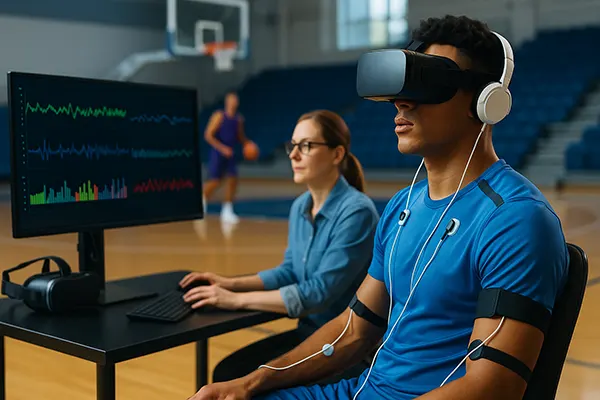Tactical Revolution: How Artificial Intelligence Analyses Football Matches in 2025
By 2025, artificial intelligence has become a decisive force shaping the way football is played and understood. What once relied on intuition and manual observation is now enhanced by advanced data models, real-time analytics, and machine learning. This technological leap has triggered a tactical revolution, allowing teams to dissect every match phase with unprecedented accuracy.
AI-Powered Match Analysis in Real Time
Modern football clubs now use AI systems to track player movements, passing patterns, and spatial dynamics during matches. These systems operate in real time, capturing data from wearable sensors and multiple camera angles to produce a live tactical overview. Coaches can adjust formations mid-game, responding instantly to the opposition’s strategies.
Heat maps and positional tracking tools powered by machine learning highlight the most exploited zones on the pitch. This data guides managers in shifting their lines of defence or exploiting weak spaces between opposing defenders. Such precision was unimaginable just a few years ago, but in 2025 it is part of the standard analytical toolkit.
Beyond positional data, AI also evaluates pressing intensity, passing tempo, and player fatigue. These insights allow teams to anticipate when rivals are vulnerable to counterattacks or when their own players risk physical decline, helping to make tactical substitutions at the optimal moment.
Collecting and Processing Big Data
Underpinning this transformation is the enormous volume of data collected from every match and training session. AI models draw from GPS trackers, biometric sensors, and video analysis systems, aggregating data into centralised performance databases. These datasets are continuously updated, providing an evolving picture of team behaviour and individual player form.
Automated data processing reduces human error and accelerates tactical feedback. Analysts no longer need to manually review hours of footage — algorithms highlight key patterns, tactical shifts, and anomalies within minutes. This allows coaching staff to focus on strategic decision-making rather than repetitive data handling.
AI systems can also identify injury risks by monitoring micro-changes in a player’s movements. Early warnings allow medical staff to intervene before minor issues escalate, preserving squad depth throughout demanding seasons.
Tactical Simulations and Predictive Modelling
Another major innovation of 2025 is the use of AI for tactical simulations. Clubs now run thousands of simulated match scenarios before key fixtures, testing how different line-ups and formations would respond to various styles of play. These models rely on both historical data and real-time form metrics.
Predictive models can forecast the likelihood of specific match events, such as goals from set pieces or transitions after turnovers. This enables managers to plan tactical traps or pressing triggers with mathematical precision. Teams that once depended on gut instinct now build strategies on statistical probabilities.
Machine learning also helps refine set-piece routines. By analysing thousands of past corner and free-kick outcomes, AI identifies which delivery styles and player movements are most effective against specific defensive structures, turning dead-ball situations into strategic opportunities.
Integrating AI Into Tactical Decision-Making
AI-generated insights are no longer confined to analysts’ laptops — they are now integrated directly into the decision-making flow of matches. Coaching staff receive live tactical suggestions on tablets during games, giving them a constantly updated tactical edge over opponents.
Players themselves benefit from AI analysis through personalised feedback reports. After each match, they receive visual breakdowns of positioning, sprint patterns, and decision-making quality, helping them refine their performance with data-driven clarity.
Clubs also use AI dashboards to monitor opponent trends throughout a season, ensuring their tactical approaches evolve as rival teams change style or strategy. This adaptability has become essential in the intensely competitive landscape of modern football.

The Ethical and Strategic Impact on Football
The adoption of AI in football raises important ethical and strategic questions. While it enhances performance, it also shifts competitive balance toward clubs with greater technological resources. Smaller clubs must find ways to access similar tools to remain competitive.
Regulatory bodies such as FIFA and UEFA are discussing how to ensure fairness and data privacy in this new era. There are growing calls to standardise data ownership rules, ensuring that players maintain rights over their personal biometric and performance data.
Despite these challenges, AI has undeniably transformed how the game is played, coached, and experienced. It has made tactical understanding deeper, preparation more scientific, and match outcomes less reliant on chance — marking a new era of strategic football.
The Future of AI in Football
Looking ahead, AI’s influence is expected to expand beyond tactical analysis. Clubs are experimenting with AI-driven scouting systems that assess young talent using pattern recognition and behavioural metrics, potentially revolutionising recruitment processes.
Another emerging field is AI-assisted fan engagement, where real-time tactical breakdowns are shared with viewers during broadcasts. This could make football more transparent and educational, changing how supporters understand the sport.
Ultimately, the tactical revolution sparked by AI in 2025 represents only the beginning. As technology advances further, its role in football will likely grow from an analytical tool to an integral element shaping the entire culture of the sport.





